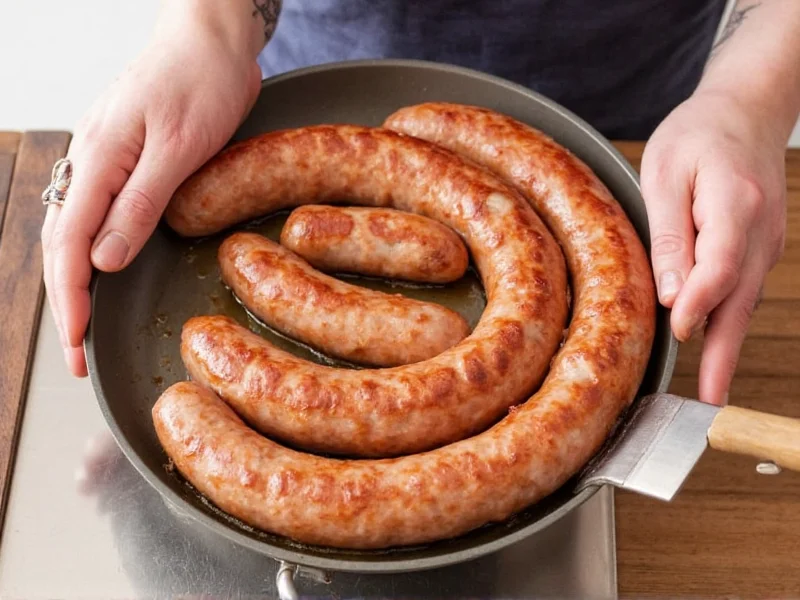The safest and most effective way to cook sausage is by pan-frying over medium heat for 15-20 minutes, turning frequently until the internal temperature reaches 160°F (71°C) for pork or 165°F (74°C) for poultry sausages. Never pierce the casing during cooking, as this releases flavorful juices and causes dryness. Always use a meat thermometer to verify doneness rather than relying on appearance alone.
Mastering Sausage Cooking: Techniques for Perfect Results Every Time
Knowing how to cook the sausage properly transforms this humble ingredient into a culinary delight. Whether you're working with bratwurst, Italian sausage, chorizo, or breakfast links, the cooking method significantly impacts flavor, texture, and food safety. This comprehensive guide covers professional techniques that ensure juicy, flavorful sausages without the common pitfalls of splitting casings or uneven cooking.
Understanding Sausage Types and Their Cooking Requirements
Sausages fall into two main categories that determine your cooking approach: fresh and cured/pre-cooked. Fresh sausages like Italian pork sausage or breakfast links contain raw meat and require thorough cooking. Cured varieties such as salami are ready to eat but can be heated for enhanced flavor. When learning how to cook raw sausage safely, always verify the packaging instructions as some specialty sausages have unique requirements.
| Sausage Type | Cooking Method | Approximate Time | Internal Temperature |
|---|---|---|---|
| Fresh Pork Sausage | Pan-fry or grill | 15-20 minutes | 160°F (71°C) |
| Poultry Sausage | Pan-fry or bake | 18-22 minutes | 165°F (74°C) |
| Bratwurst | Parboil then grill | 25-30 minutes | 160°F (71°C) |
| Smoked Sausage | Heat through | 10-12 minutes | 140°F (60°C) |
Essential Preparation Steps Before Cooking
Proper preparation prevents common sausage cooking disasters. Remove sausages from refrigeration 20 minutes before cooking to bring them closer to room temperature, ensuring even cooking. Never pierce sausages before or during cooking—this releases precious fat and juices that keep the meat moist. For the best way to cook sausages without burning, start with a cold pan when using the dry heat method, allowing the fat to render slowly as the pan heats.
Four Reliable Cooking Methods Compared
Pan-Frying: The Most Consistent Results
Pan-frying delivers the most reliable results for how to cook sausage indoors. Use a heavy skillet over medium heat with no added oil (sausages contain enough fat). Place sausages in a single layer without crowding. Cook for 15-20 minutes, turning every 3-4 minutes until evenly browned. For thicker sausages, finish in a 350°F oven for 5-10 minutes after searing. This method for cooking different types of sausage works exceptionally well for Italian sausages and breakfast links.
Grilling: Achieving Perfect Char Marks
Grilling imparts distinctive flavor but requires careful temperature management. Preheat grill to medium (350-400°F). Place sausages on indirect heat first for 10-12 minutes, then move to direct heat for 3-4 minutes per side to develop grill marks. How long to cook sausages on the grill depends on thickness—thicker varieties like bratwurst need the two-stage approach to prevent bursting while ensuring thorough cooking.
Baking: Hands-Off Precision Cooking
Baking provides consistent results with minimal attention. Preheat oven to 375°F. Place sausages on a parchment-lined baking sheet with space between them. Bake for 20-25 minutes, turning halfway through. This method works particularly well for how to cook raw sausage safely when preparing multiple servings, as oven temperatures remain stable and eliminate flare-up risks.
Parboiling: The Professional's Secret for Juicy Results
Many chefs use parboiling before finishing with dry heat. Simmer sausages in gently boiling water or beer for 10-12 minutes until partially cooked, then finish on the grill or in a pan. This technique prevents casing rupture while ensuring thorough cooking—especially valuable for how to cook bratwurst properly without losing their signature juiciness.
Food Safety Essentials Every Cook Must Know
Understanding internal temperature requirements is non-negotiable for safe sausage consumption. Pork and beef sausages require 160°F (71°C), while poultry sausages need 165°F (74°C). Invest in an instant-read thermometer—color alone cannot verify doneness. Never rely on the common misconception that sausages must be gray throughout; properly cooked sausage can retain a slight pink hue while being perfectly safe. When cooking multiple sausages, check the thickest specimen as cooking times vary by size.
Troubleshooting Common Sausage Cooking Problems
Skin splitting: Caused by high heat or piercing. Solve by starting with cold sausages in a cold pan and cooking slowly. Uneven browning: Results from inconsistent heat. Rotate sausages frequently and use a heavy-bottomed pan for even heat distribution. Dry texture: Usually from overcooking or piercing. Always use a thermometer and resist the urge to prick sausages. Flare-ups on grill: Move sausages to cooler part of grill immediately and close lid to smother flames.
Serving and Storage Recommendations
Allow sausages to rest for 5 minutes after cooking to redistribute juices. Serve with complementary sides like sauerkraut, peppers and onions, or potato salad. For leftovers, cool completely within 2 hours and store in airtight containers for up to 3 days. Reheat gently in a covered skillet with a tablespoon of water to prevent drying. Never refreeze previously frozen cooked sausage.











 浙公网安备
33010002000092号
浙公网安备
33010002000092号 浙B2-20120091-4
浙B2-20120091-4